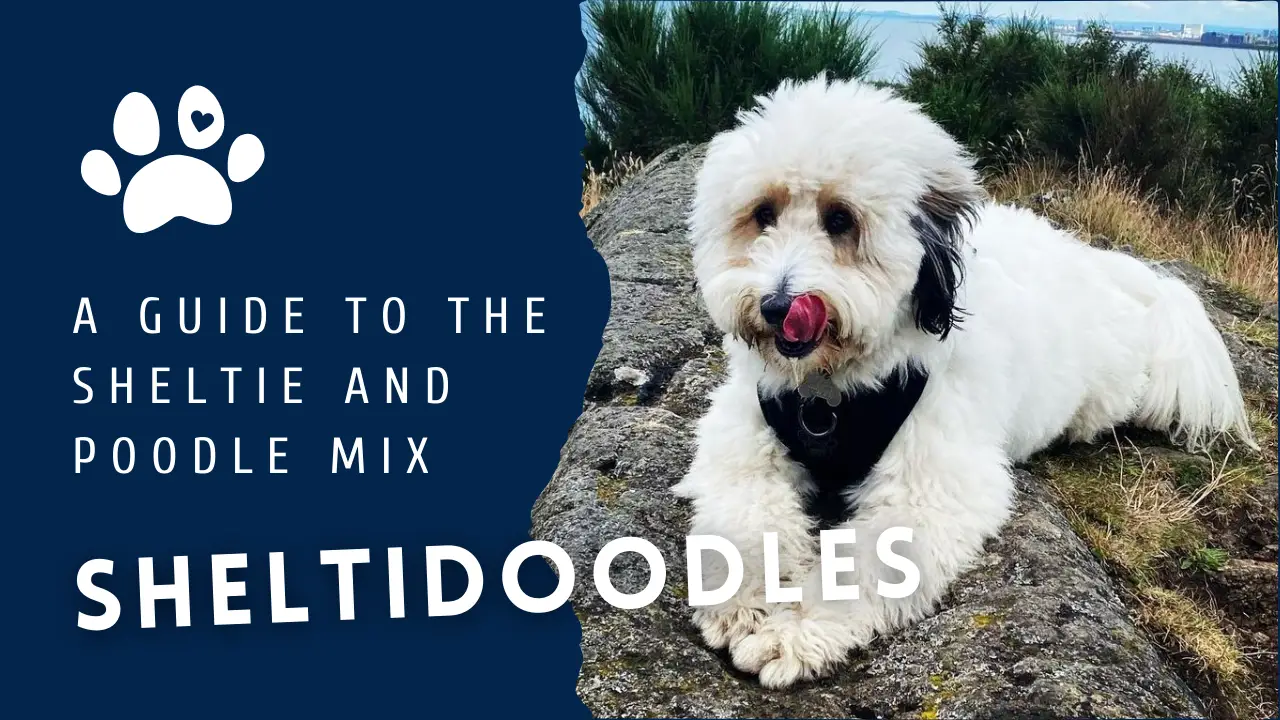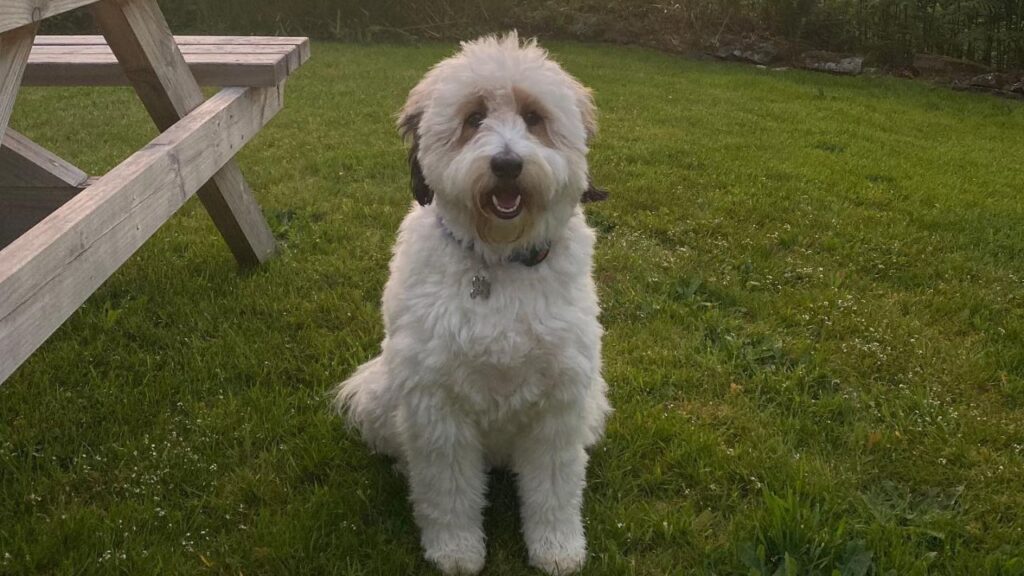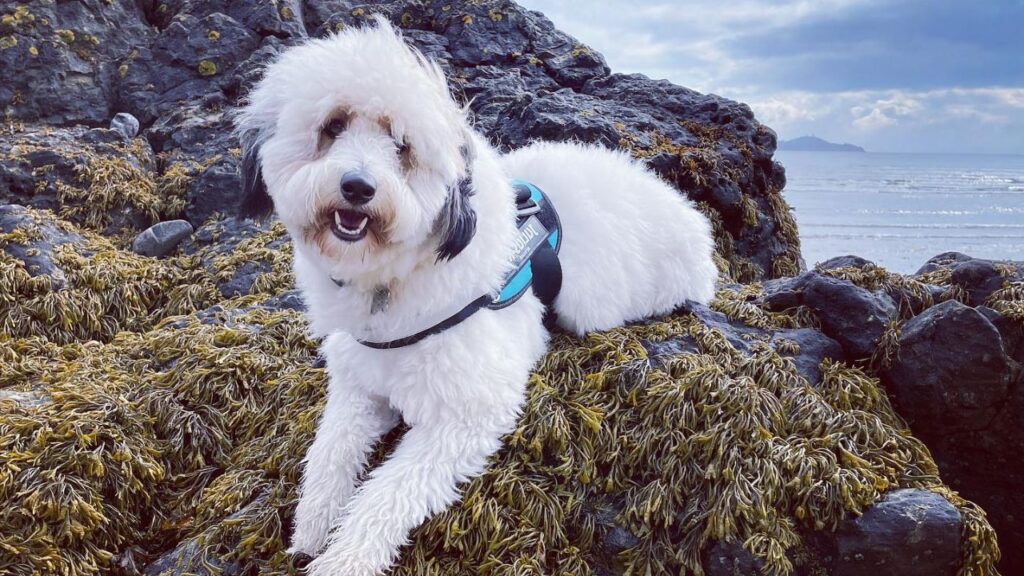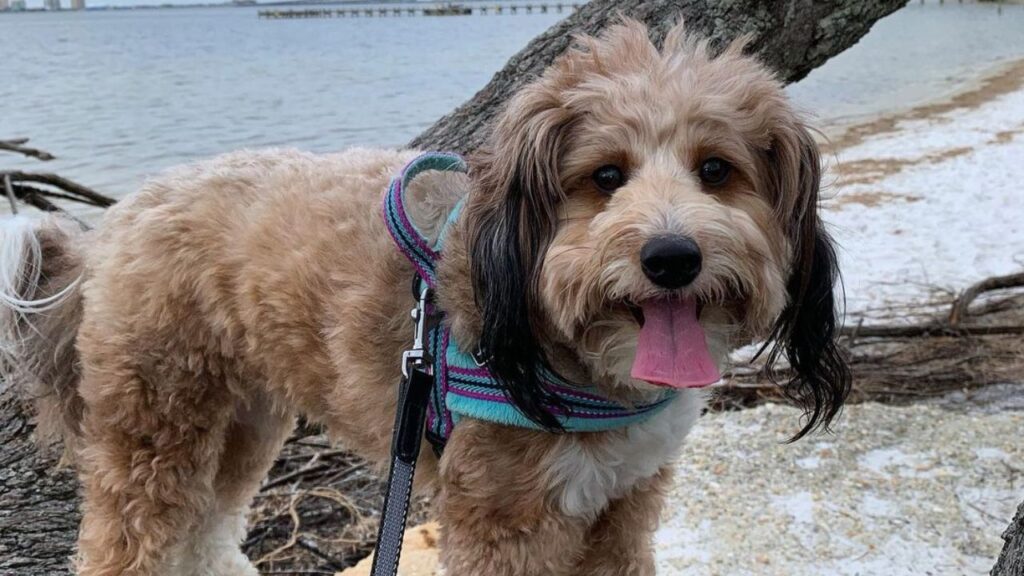One of the fluffiest doodles you can find in the world by far has to be the Sheltidoodle!

This medium-sized designer breed is the child of the Poodle and the stunning Shetland Sheepdog.
This breed has a life expectancy of 12-15 years and comes in a combination of colors.

Read our Smart Poodles - Smart Tricks eBook for only $2.99
Dive into a treasure trove of engaging tricks and tips designed specifically for your poodle!
What draws many people to bring this dog into their homes is its sweet and gentle nature, making it a great canine for children.
Does it sound like a dog you like to buy?
Well, keep on reading to see if a Sheltidoodle truly aligns with your circumstances and interests.
What Will You Learn? 👇
Parents history 📚
To know more about this hybrid, we have to explore its parents’ basic history and characteristics.
Poodle
The Poodle originated from Germany and later on became popular in France, becoming the country’s national dog. Its main reason for breeding was to be a dog that hunted ducks and birds.
Over time this dog became more domesticated and became an accessory item for the rich and entered into many dog shows. Today the Poodle exists worldwide and comes in three types: Standard, Miniature, and Toy. It also has a soft single curly coat that does not shed and is known to be highly intelligent.
Shetland Sheepdog
The Shetland Sheepdog comes from the and islands of Scotland. It was originally bred to be a herding dog, gathering lots of animals into one place. It’s believed that they first originated in Scotland in 1908. Shetland dogs are known for their double undercoat that is short and dense. Plus, they’re highly obedient dogs, affectionate, and love to devote themselves to family.
Now given these two marvelous parents, are you ready to know what a Sheltidoodle might inherit?
Sheltidoodle appearance 🐩
The Sheltidoodle is a medium-sized breed growing up to on average 14-19 inches/35-48cm in height and weighs between 40-50lbs/18-22 kg.
If you’re a fan of smaller dogs, you can potentially get Sheltidoodle’s that are a lot smaller in size that is bred from a Shetland Sheepdog and Minature Poodle. These Sheltidoodle’s weigh between 25-35lbs/11-15 kg, and there are even toy Sheltidoodle’s weighing between 15-25lbs/6-11kg based on their breeder.

Because of their size, they’re a breed that is best suited to living in a larger home with a backyard; they’re not necessarily an apartment dweller. They can live in apartments, though, as long as they get sufficient exercise each day.
In terms of their structure, the Sheltidoodle tends to be like both parents having a square build with deep chests and straight legs. The Sheltie Poodle mix inherits a similar facial structure to their Shetland Sheepdog parent most of the time. This means they have a wedge shape face and a long muzzle that has a round end.
There are situations where this breed does inherit some Poodle characteristics having a narrow head and narrow head. Regarding their eyes, they are the same shape, an oval or almond shape, and are medium size.
A Sheltidoodle’s eyes can usually come in two colors which are either brown or blue. However, their ears can vary slightly, either having pointy triangular ones like the Shetland Sheepdog or long floppy ones like the Poodle.
The coat of a Sheltidoodle is also interesting as their parent’s coats are contrasting! The Poodle has a single-layered coat that is short and soft, whereas the Shetland Sheepdog has a double coat that is long and straight.
This makes it quite unpredictable for the Sheltidoodle as they can either inherit a single or double coat. Most of the time, the coat they inherit is curly or wavy. This breed also has a range of coat colors: black, brown, white, sable, blue, cream, gray, red, or silver.
Temperament ✨
If you’re the type of person who does not wish to have a troublemaker or mischievous dog in your household, then you’re in luck with the Sheltidoodle. This breed is anything but; it has a loyal and well-behaved personality. It also inherits both parent’s intelligence making them an easy to train breed from an early age.
Regarding their intelligence, they also double up as great therapy dogs! This breed is quick to pick up on human emotions and responds to them quickly.
Unlike other hybrids, the Sheltidoodle does not have an aggressive element in them, making them a poor watchdog against strangers. However, this can have many benefits, allowing them to warm easily towards strangers, children, and other family members.

On the contrary, if you’re an outgoing person who intends to leave your dog for long periods in your home, then this breed does not do very well being alone for long hours without human interaction. If you leave a Sheltiepoodle mix on its own for too long, it will develop self-destructive behaviors.
Grooming requirements ✂️
As mentioned previously, the coat inheritance of a Sheltie Poodle mix can be quite unpredictable. Its Poodle parent does not shed much, it’s practically hypoallergenic, and its Sheltidoodle parent has a double coat that sheds heavily and is not hypoallergenic.
Because of this uncertainty, if you’re someone who suffers from many allergies, you should visit the breeder and see a Sheltidoodle in person before bringing one home.
This will give you an idea of what coat they have, and if you’re unsure how your allergies might play up, you could look after one for the weekend.
Anyways, back to grooming!
If this doodle has a coat like the Shetland Sheepdog, it will require more grooming. You will need to have a lot of time to groom this dog at least 2-3 to stop profuse shedding of hairs and dog danger lingering all over your furniture. Ideally, if you can, you should brush this dog daily using a pin brush.

Do note that the longer the coat becomes, the more grooming a Sheltidoodle will need, as its coat could get tangled and matted easily. It’s for this reason you will want to take it to the groomers every 6-8 weeks to be trimmed and styled.
You should consider trimming their nails every week; a good sign of them growing too long is that you can hear them scratching across the floor when they walk. If you don’t feel confident enough doing this, you can also get them done by a professional.
Similarly, if they have ears like a Poodle, you should check and clean them a few times a week a sweat, bacteria, and dirt can accumulate in them easily. These doodle’s teeth also need to be brushed 2-3 times a week to prevent the accumulation of tartar and reduce their risk of tooth decay.
Health problems 💊
If you’re planning on owning a Sheltidoodle, you should be aware of the potential health problems they might face. It’s not always guaranteed that they will have them, however, they could be at risk of the following:
Major issues
- Hip dysplasia: When the ball and socket in their hip joint grow at different rates causing mobility issues and often osteoarthritis when they get older.
- Gastric Dilation Volvulus (GDV): This is also known as bloat, and it causes a Sheltidoodle’s dog stomach to fill up with gas-causing vomiting, swollen stomach, stomach pain, retching, and, in the worse case, collapse.
- Patent Ductus Arteriosus (PDA): A continuous murmur across their heart, reducing their life expectancy dramatically.
- Von Willebrand’s Disease: An inherited bleeding disorder pass down from their Poodle or Shetland Sheepdog parent. This disorder occurs when insufficient proteins help their blot clot, causing mild to severe bleeding.
- Sebaceous Adenitis Ulcerative Dermatosis: A inflammatory skin disorder that causes hair loss, coat changes, intense itching, and more.
Minor issues
- Diabetes: When their pancreas produces too little or too much insulin.
- Glaucoma: An increase in eye pressure causing pain and redness.
- Cataracts: This is when their eye lens clouds over, causing problems with their sight leading to blindness.
If you sense your dog might have any of these, it’s important to immediately take them to a vet. However, as a pet owner, you should be taking your dog for regular health checkups a few times a year to rule out any of these underlying diseases.
Sheltidoodle Puppy cost 💲
On average, a Sheltidoodle costs in the USA between $200-$550, that’s if you’re looking to buy them from a reputable breeder. However, do take note, that’s just for the puppy, and you should budget for their food, toys, medical bills, vaccinations, and other puppy essentials.
You should also be aware that outside of the USA, the price might vary, and you should speak to registered breeders in your area to get an idea of the costs. Similarly, the price can also fluctuate based on the dog’s bloodline and the breeders reputation.

When buying from a breeder, it’s not always guaranteed you’re getting a dog from a loving environment; you could be at risk of bringing one home from a puppy farm. Therefore you will want to ensure you see the breeder’s credentials and visit them in their home before buying any Sheltidoodle.
Final thoughts ✔️
Sheltidoodle’s are a loving yet energetic breed; regardless of their size, they need to have ample space to run around in. They may be able to live in an apartment, but they’re only suitable if you can commit enough time to exercise them.
Moreover, if you suffer from a lot of allergies, this breed can be quite unpredictable as they can either shed lots of hair or very little. It’s always a good idea to visit a breeder in person and seeing the dog’s coat before buying.
Do you mind a dog shedding lots of fur? Let us know in the comments down below.
Marko is the founder and author at PoodleHQ, where he blends profound expertise with formal training in Animal Behavior and Canine Genetics. With multiple generations of poodles under his care, he’s a breed connoisseur, honored with the Canine Care Excellence Award and lauded by the International Pet Enthusiasts Association.

